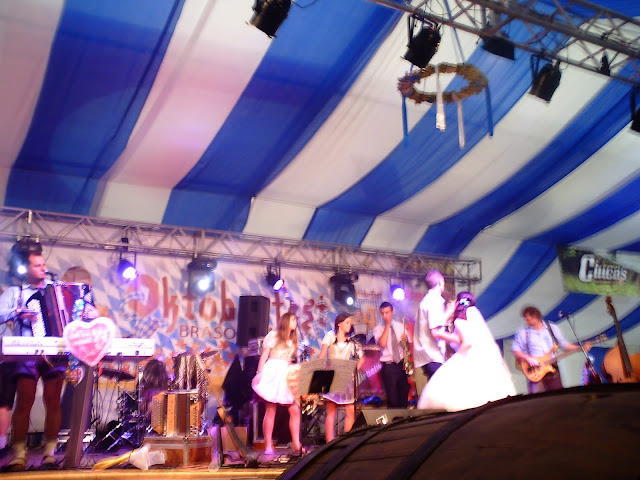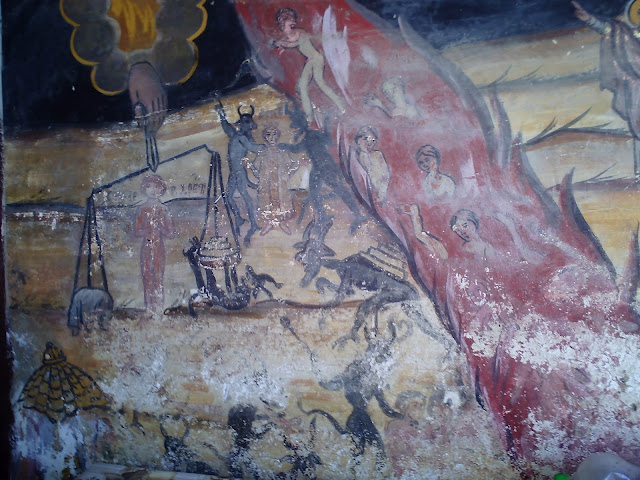

 |
| Ram spit |
 |
| Calf spit |






 |
| Peasant's pantry |



Afterwards we went to the Oktoberfest organised yearly by the German population. The locals were saying that this year it was better organised than the last ones. Here are some pictures with the German band entertaining the happy atmosphere. A "kidnapped" bride (a customary stage in a Romanian wedding) made an appearance and was invited to a waltz by her "kidnapper".




 Opera in the Council Square
Opera in the Council SquareDeciding to go to Oltenia through a road going through the Retezat Mountains ( Transalpina), we passes through a lot of very nice villages.
I liked Fagaras, a very small and quiet town and, of course, I managed to find a pastry shop immediately. I fell in love with its' German style painted furniture and delicious cakes.



Going on the road again, I notice that almost in every village we went through, there was a soccer match on the local fields. Nice way to entertain yourself on a Sunday. I liked to see those men in very nice equipment running on the green pasture. There was no public, gallery or press, but they were definitely enjoying the game.

In Targu Jiu, even if I go there often enough, I don't feel I've been there it i haven't gone through the central part with the sculptural works of Constantin Brancusi. Thy are Targu Jiu for me.
When I go through this town, I like the air of history given by the old traditional buildings, like the Town Hall.
 |
| The Endless Column in another park |
This one amused me, with its God held scale which shows that a rich man weighs more than a devil. Obviously this painting was meant to show that the boyars had more sins than a devil. It must have been very rewarding for peasants to see that their boyars will have a hard life in hell, in the hands of the devils and drowning in a river of blood.
I liked also the big devil's head, even if a bit eroded by time.
On the hill next to the church there was a cemetery with older and newer grave crosses, nothing unusual for a Romanian village church. But what I noticed, were the few crosses at the entrance in the church yard. Some were really old and the stone writing had been wiped by the elements so I couldn't figure out the years.
I liked the cross picture depicting two peasants in their national costumes. This must have been one of the first pictures taken in the region and the two, obviously wealthy peasants, seemed very proud to have their picture taken.
I know that the village church was a important place for the education of Tudor Vladimirescu, and perhaps the images depicting the sins of the oppressive boyars were one of the things which inspired him and his followers to rise against them. http://en.wikipedia.org/wiki/Tudor_Vladimirescu
The house, a reconstruction on a lower terrain, was a step back in the past. I saw village museums, but they usually have the most beautiful villages houses, chosen by interested collectors. This one was representative in the sense that it had belonged to a common poor peasant family. Nothing unusual or spectacular, only things with a strict utility.

As usual I take the time to caress the wood work. The stellar/ sun pattern which can be found on the Maramures gates or on the mountain churches, reminding me of the pagan roots of local Christianity, was present also here. It was one of the few decorations of the place.


This visit made me think of the efforts made my our ancestors for some rights. The land was so important for the peasants who fought together with Tudor, but now it seems some of their grand-grand children have lost their love for this land.
The house was opened for us by the husband of the museum caretaker. We wanted to give him a sum as a retribution for letting us inside, but he was very reluctant to take it and when he finally took it, he gave us back a lot of small things, souvenirs which were worth much more than we gave him, He seemed to really like his talk with us and we finished by sharing a lot of things from our history reflections to our regional problems and family details. He told us he had been mayor of the village for three mandates and told us some of the problems people there have. At the end, seeing us admiring his trees, he started shaking two apple trees in his yard and filled us a bag of apples. We had to insist that it was enough as to sop him going to another tree.
This time, I felt dissaponted, like a child whos has been told there is no Santa Clause. I felt Transalpina lost its fairy -tale feeling. The long drought made the grass brown and dull, the ponds dissapeared as if never there and I felt its increased popularity made it loose the charm a hidden place has.
I didn't like the food stands which appeared on the largest plane space, even if they sold traditional food. I felt that they steal the attention that you have to pay to the magnificent scenery around. After all, that'sthe reason you go ther, not to eat, which you can do anywhere. Walking around, I felt like the place didnt' have the purity I felt before there. There certainly are people who feel the need to distroy beautiful thing. Why else would you leave behind a plastic bottle, bag or pieces of paper on an immaculate moutain plane?
All right, enough with pessimistic thoughts. On the road, I was also amused to see some donkies, run-aways from the near-by sheepfolds, stopping the traffic with an indiferent posture. They seemed less curious about the cars going around them and mare outraged that we were standing in their way.
The mountains are my favourite summer destination, they never ceise to amaze me. You can see a gorgeous scenery at every corner.





























